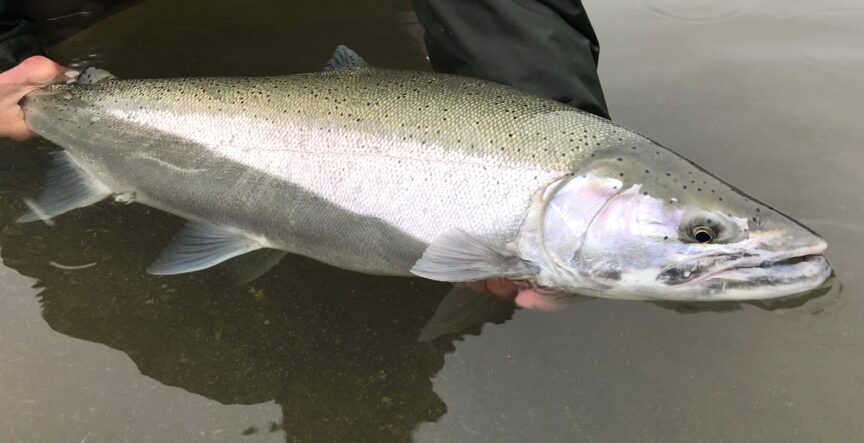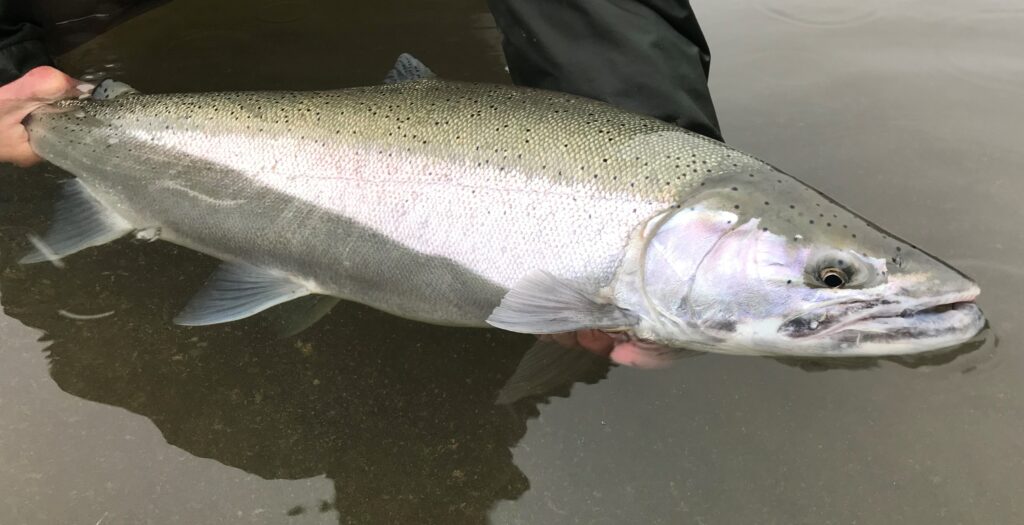
Our Science Advisor looks at the winter forecast, ocean temperatures, and the impacts on steelhead in the Pacific
Meteorologists from the National Weather Service have documented the emergence of El Niño conditions in the Pacific Ocean, which are expected to strengthen into the winter. El Niño is a natural climate phenomenon that occurs every two to seven years and brings unusually warm sea surface temperatures to the northern Pacific Ocean. In the Pacific Northwest, this typically means warmer and drier winters. For Pacific salmon it is typically associated with lean times and poor survival. What about steelhead?
This El Niño is coming on the heels of nine years of marine heatwaves in the North Pacific, which has had extensive impacts on steelhead populations up and down the coast. In many watersheds, run numbers have yet to recover from these consecutive periods of warm water and reduced productivity. Considering this, does another El Niño spell certain doom? Based on past events, another El Niño answer is likely not good news, but how El Niño impacts steelhead is complicated due to the life history traits and distribution of steelhead in the North Pacific.
Steelhead Lives at Sea
While Pacific salmon spend most of their first summer in the ocean foraging in productive waters along the continental shelf, steelhead take a different strategy and make vast migrations across the less productive offshore waters of the open ocean. While these open ocean waters are typically less productive, they also hold fewer predators, and steelhead typically make up the difference in prey abundance by seeking out high-energy prey species such as fish and squid.
In addition to their different oceanic distribution, steelhead also have a narrower window of preferred ocean conditions than Pacific salmon, which inhabit a variety of depths while in marine waters. Steelhead generally reside in the top 15 feet of the water column and seek out temperatures between 40 °F and 60 °F, with optimum growth occurring while temperatures are in the low 50’s °F (Courtney et al. 2022, Atcheson et al. 2012).
Unfortunately, these life history traits make steelhead particularly sensitive to conditions associated with El Niño because warm water restricts the patches of suitable foraging habitat in the north Pacific and changes the prey composition in the open ocean from being by lipid rich northern copepods to lipid poor southern copepods, which reverberates up the entire food web.
Lessons from past El Niño events
In some cases, warm phases associated with El Niño may actually improve conditions for steelhead in the Pacific Ocean. A study by Sobcinski et al. (2020) looking at marine survival indicators for Puget Sound steelhead found just that, suggesting that while Pacific Salmon were negatively impacted by warming trends, steelhead showed a positive relationship. Similarly, Ward et al. (1989) found that a mild El Niño event from 1982-1983 resulted in higher smolt to adult survival for Keogh River, British Columbia steelhead, but found that the fish returned at smaller sizes.
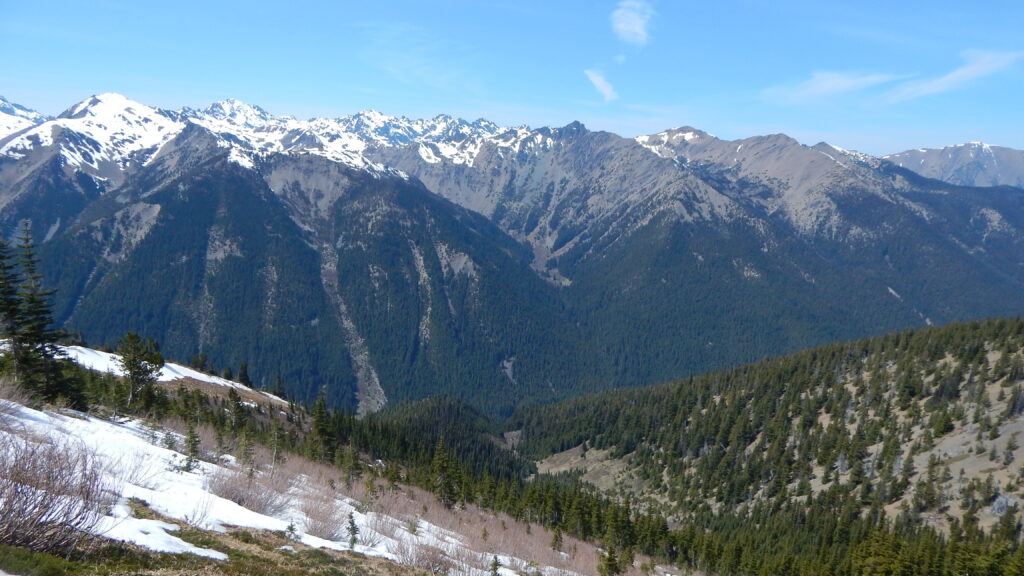
The mechanisms for this positive relationship appear to be tied to the conditions leading to optimum growth for steelhead during their years in the ocean. For example, Atcheson et al. (2012) found that while the 1997 El Niño resulted in a diet composed of low energy food items, steelhead feeding rates were near optimum and significantly higher than during a La Nina (El Niño’s cold and wet phase counterpart) event in 1999 where steelhead had a much more energy rich diet.
Unfortunately, before getting excited about upcoming improvements in steelhead survival, it is important to temper expectations with lessons from other studies and more recent El Niño events.
First, in Puget Sound, the primary marine survival bottleneck occurs as smolts travel through Puget Sound and has been linked to high predation rates (Morre et al. 2021). This is important, as warm water conditions associated with El Niño bring abundant schools of Northern Anchovies to the Puget Sound. These baitfish numbers appear to buffer predation impacts on juvenile steelhead, thus resulting in positive response to warmer ocean conditions, which may explain some of the Sobcinski et al. (2020) results.
Next, a study by Friedland et al. (2014) digging into the mechanisms impacting steelhead survival in the Keogh River found that when and where warm sea surface temperatures are distributed in the ocean makes a big difference for steelhead survival. They found that warm conditions extending into the first summer and fall steelhead spend at sea have a significant negative impact on their survival. Warm water in the California current and offshore areas south of the Gulf of Alaska resulted in reduced survival in the spring, while warm water in offshore areas south of the Gulf of Alaska reduced survival in summer and fall.
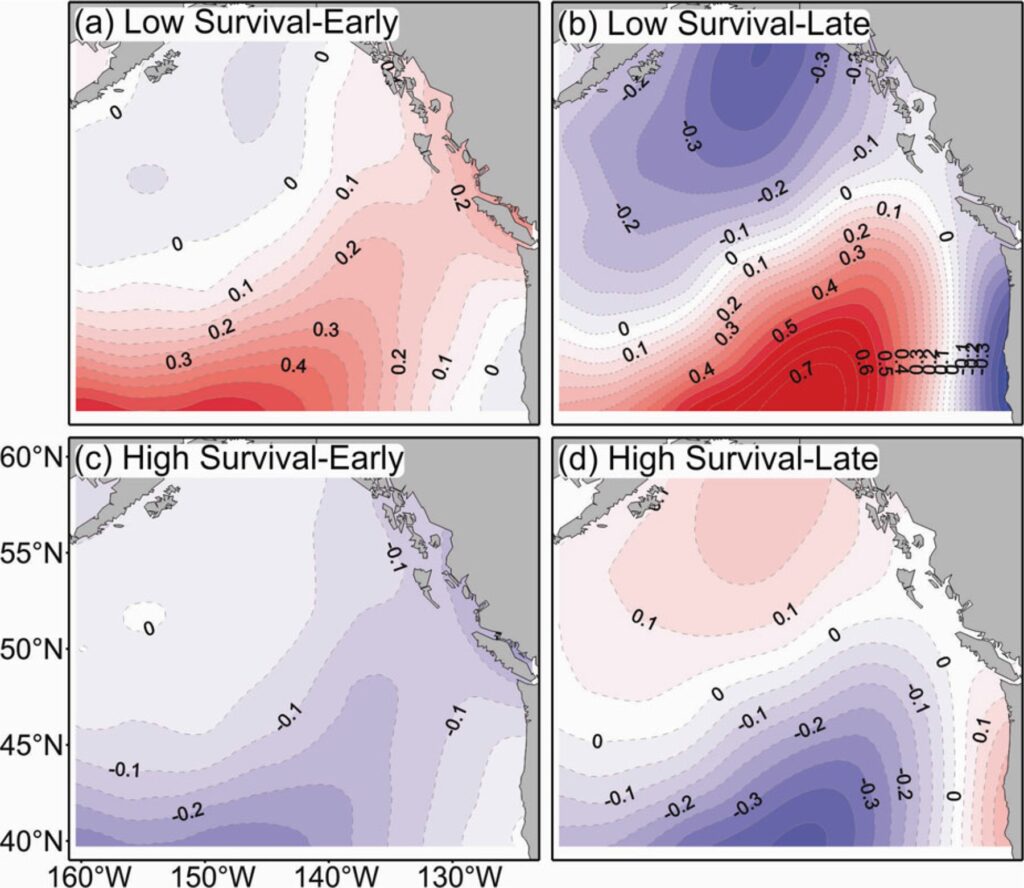
The most recent El Niño event from 2014 to 2016 also provides reason for concern as it caused sea surface temperatures to rise by 5 °F and kicked off a significant downturn in steelhead survival throughout the Pacific Northwest. That El Niño event resulted in significant changes to the food web of the north Pacific Ocean, which shifted from energy rich prey items item such as euphausiids (krill) to low energy prey items like juvenile rockfish and gelatinous species such as salps. On top of the lower energy prey, the abundance of prey was also significantly lower than normal during this time period. As a result, steelhead were not able to feed at a high rate. As a result, while juvenile steelhead grew in the length, they also lost weight during their early marine residence. Troublingly, the adult returns from smolts entering the ocean between 2014 to 2016 were some of the lowest on record.
The Impacts Beyond the North Pacific
It is also important to remember that El Niño doesn’t just impact steelhead at sea, but the warmer and drier weather pattern also results in warmer freshwater temperatures and lower stream flows. For example, during the 2015/2016 El Niño event, the Olympic Mountains in Washington saw a near total snowpack failure when they received only 3% of normal snow levels, with the Cascades also seeing similarly weak snowpacks. As a result, a record drought occurred during the summer of 2015, with river flows at record lows in many locations across the region, negatively impacting the survival of juvenile salmonids in freshwater.
Current forecasts suggest that this El Niño is setting up similar to the one in 2015-2016, but just how impactful this El Niño event is only time will tell. Steelhead display a vast amount of life history diversity, an evolutionary strategy which has allowed them to weather challenging conditions in both freshwater and the marine environment throughout time. This diversity often allows them to bounce back once conditions improve, as long as enough of the run is able to spawn and their habitat is intact and connected.
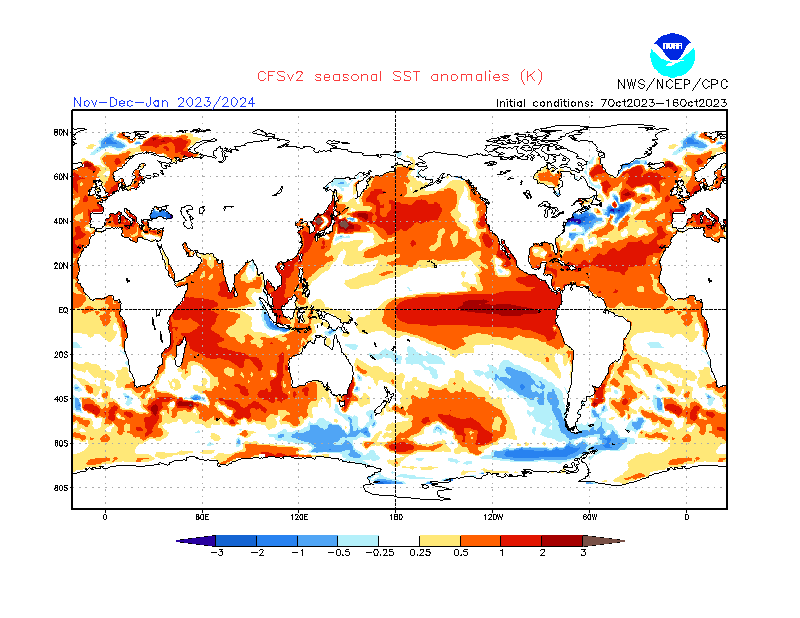
Coming off an extended period of record low steelhead returns largely attributed to marine heatwaves, which are just predicted to get worse in the future due to climate change, it is essential that fisheries managers shift their focus beyond individual seasons to a long-term outlook. Old models of fisheries management focused on maximum sustained yield and outdated escapement objectives need to be revisited.
This is why Wild Steelheaders United is pushing for fishery policy aimed at rebuilding steelhead populations to ensure that we consistently get more fish on the gravel. In addition, our colleagues across Trout Unlimited are leading extensive projects to restore spawning and rearing habitat and remove culverts and dams that block access to high quality habitat. The incredible diversity of wild steelhead is a powerful advantage, but these fish need conservation-focused management to be able to take advantage of good conditions and weather downturn cycles.


